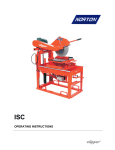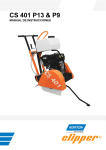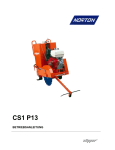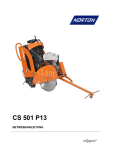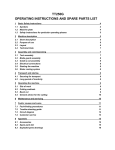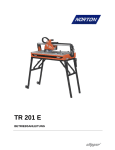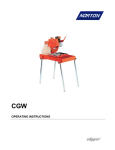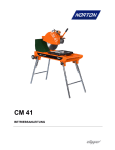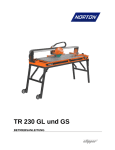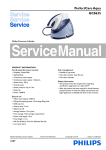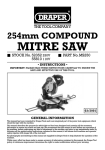Download clipper_c71_manual_en
Transcript
C71 OPERATING INSTRUCTIONS 2 Declaration of conformity The undersigned manufacturer: SAINT - GOBAIN ABRASIVES S.A. 190, BD J.F. KENNEDY L- 4930 BASCHARAGE Declares that this product: Floor saw: C71 P13 HONDA CYLONIC Code: 70184623802 is in conformity with the following Directives: • European Machinery Directive 2006/42/EC • Electromagnetic Compatibility Directive 2004/108/EC and European standard: • EN 13862 – Floor cutting-off machines – Safety Pierre Mersch Business Manager Machines Europe 3 4 C71 OPERATING INSTRUCTIONS 1 Basic Safety Instructions 6 1.1 Symbols 1.2 Machine plate 1.3 Safety instructions for particular operating phases 6 7 7 2 General description of the C71 8 2.1 Short description 2.2 Layout 2.3 Technical data 8 8 10 3 Assembly and commissioning 11 3.1 3.2 3.3 3.4 11 11 11 12 Assembly Tool assembly Water cooling system Starting the machine 4 Transport and Storing 13 4.1 Securing for transport 4.2 Transport procedure 4.3 Long period of inactivity 13 13 13 5 Operating the C71 14 5.1 Site of work 5.2 Cutting method 14 14 6 Maintenance and service 15 6.1 Maintenance of the machine 6.2 Maintenance of the engine 15 16 7 Faults: causes and cures 19 7.1 Fault-finding procedures 7.2 Trouble-shooting guide 7.3 Customer service 19 19 19 5 1 Basic Safety Instructions The C71 is exclusively designed for the cutting of floors made of asphalt, green and cured concrete (reinforced or not) as well as of industrial cement. Uses other than the manufacturer's instructions shall be considered as contravening the regulations. The manufacturer shall not be held responsible for any resulting damage. Any risk shall be borne entirely by the user. Observing the operating instructions and compliance with inspection and servicing requirements shall also be considered as included under use in accordance with the regulations. 1.1 Symbols Important warnings and pieces of advice are indicated on the machine using symbols. The following symbols are used on the machine: 6 Read operator’s instructions Ear protection shall be worn Cutting depth indicator Emergency Stop Rotation of the wheel in the indicated direction lowers the blade Rotation of the wheel in the indicated direction raises the blade Never move the machine with the blade running idle. Danger: risk of cut 1.2 Machine plate Important data can be found on the following plate located on the machine: Machine Model Machine Type 1.3 Machine Code Serial Number Weight Power Year of production Maximum blade Diameter Bore Diameter Safety standard Blade speed Safety instructions for particular operating phases Before commencing work • Before commencing work, make yourself familiar with the working environment at the place of use. The working environment includes: obstacles in the area of work and manoeuvre, the firmness of the floor, necessary protection at the site relating to public thoroughfares and the availability of help in the event of accidents. • Check for correct mounting of the blade regularly. • Immediately remove damaged or badly worn blades, as they endanger the operator whilst rotating. • Always cut with the blade guard in position. • Only fit NORTON diamond blades to the machine! The use of other tools can damage the machine! • Attention is drawn to the use of BS2092 safety goggles in conformity with specified Processes No.8 of the Protection of Eyes Regulation 1974, Regulation 2(2) Part 1. • For security reasons, never leave the machine unattended, untied or unlocked. While the engine is running • Do not move the machine whilst the blade is running idle. • Do not run the machine without the security guards in place. • Apply cooling water continuously whilst cutting and in good time! Petrol powered machines: • Always use the fuel advised. • In confined areas, exhaust gases should be evacuated and the job site properly ventilated. • Petrol and diesel machines, which by their nature emit toxic exhaust gases, must not be used in places prohibited by the Health at Work etc. Act 1974 or which are prohibited by Factory Inspectors or Safety Officers. • Fuel is flammable. Before filling the tank, shut down the engine, extinguish all open flames and do not smoke. Take care that no petrol is spilled on any motor part. Always wipe up spilled fuel. 7 2 General description of the C71 Any modification, which could lead to a change in the original characteristics of the machine, may be done only by Saint-Gobain Abrasives who shall confirm that the machine is still in conformity with the safety regulations. Saint-Gobain Abrasives keeps the right of making technical or design modification without prior notification. 2.1 Short description The Floor Saw C71 you have chosen, is used for small repair works in concrete and asphalt, for cutting induction loops and installing cables as well as for cutting expansion joints. It can be used for either wet or dry cutting operations. Being of small construction, it can be transported in a car or van, the handle can be removed, reversed or retracted. The water container is also removable. All component parts on the C71 are assembled to a high quality standard, ensuring long life, reliability and a minimum of maintenance. Special types of blades are available for asphalt, green concrete, cured concrete (reinforced or not) as well as for industrial cement flooring. 2.2 8 Layout Made of jig welded open profile steel, the C71 (1) is stable but at the same time, easily transportable. The one-piece blade guard (2) fully protects the operator and his working environment. It is firmly fixed to the main frame. A handle on the top of the blade guard facilitates its removal when changing blades. A manually operated hand wheel mechanism (3) enables graduated depth setting. Turning the hand wheel clock- or anti-clockwise will raise or lower the cutting blade. A depth gauge allows a precise control of the cutting depth. The precisely manufactured blade shaft is fitted into two heavy-duty self-aligning pillow block bearings, including grease nipples. The shaft is 32mm in diameter. A four-belt taper lock pulley is fitted on one end. The shaft is reduced to 25,4mm at the other end, allowing an inner flange complete with dowel pinholes to be fixed. The steel belt guard (4) is a sealed two piece unit. The backing plate is bolted to the mainframe of the machine and four locking nuts are welded to it. The outer guard, covering the four drive belts and taper lock pulleys, is held in place by two locking bolts. The water cooling system is composed of a 20 litres water tank (5), a water tank tap and two water nozzles located on the blade guard ensuring adequate flow of water to both sides of the cutting blade. The Honda GX390 engine (7) is connected to an emergency shut down switch (6) on the right side of the machine near the levers. This allows an immediate stop of the machine in case of danger. The handle (8) is detachable or can be reversed for easy transportation. The height is adjustable. The pointer (9) allows the operator to make precise cut easily. 9 2.3 Technical data Engine Fuel Starter Oil Max. blade diameter Bore Max. cutting depth mm Flange diameter Blade shaft speed Driving belts Water tank Machine dimensions Weight Max. operating weight Sound pressure level Sound energy level 10 Honda GX390, 4 strokes, 1 cylinder, 13HP (9,6kW), Dual filter Regular unleaded Manual pull chord Honda 4-Stroke, or equivalent high detergent, premium quality motor oil certified to meet or exceed U.S. automobile manufacturer’s requirement for service classification SG, SF. (SG, SF designated on the oil container). SAE 10W-30 recommended 400 mm 25,4 mm 140 mm 108 mm 2850 min-1 4 20 l 1190x535x960 mm (working) 965x535x960 mm (transport) 92 kg 118 kg 88 dB (A) (ISO EN 11201) 105 dB (A) (ISO EN 3744) 3 Assembly and commissioning Before beginning the work with the C71, you have to assemble some parts. 3.1 Assembly Secure the operator’s handle in a comfortable user position by using the two locking screws. 3.2 Tool assembly Only use NORTON blades with the C71. A blade with a maximum diameter of 400 mm can be fitted in the C71. All tools used must be selected with regard to their maximum permitted cutting speed for the machine’s maximum permitted rotation speed. Before mounting a new blade, switch the machine off. To mount a new blade, follow these steps: • Turn the wheel until the cutting head is in the raised position. • Disconnect the water tank. • Loosen the side screw and remove the blade guard. • Loosen the hexagonal nut on the blade shaft, which holds the removable outer flange. • Remove the outer flange. • Clean the flanges and blade shaft and inspect for wear. • Mount the blade on the shaft ensuring that direction of rotation is correct. Wrong direction of rotation blunts the blade quickly. • Replace outer blade flange. • Tighten hexagonal nut with spanner supplied for this purpose. • Remount the blade guard. The blade bore must correspond exactly to the blade shaft. Cracked or damaged bore is dangerous for the operator and for the machine. 3.3 Water cooling system Fill the water tank with clean water. Open water-tap at blade guard (note that handle on water-tap should be in line with water-flow). Ensure that water is flowing freely in the circuit and delivers water adequately to both sides of the blade, as insufficient water supply may result in premature failure of the diamond blade. In case of frost, empty the water cooling system. 11 3.4 Starting the machine Make sure the blade is raised clear up the ground before starting the machine. Turn the fuel valve to the ON position. Move the choke lever to the CLOSED position. NOTE: do not use the choke if the engine is warm or the air temperature is high. Move the throttle control lever slightly to the Put the engine switch on ON, and make sure left. the emergency switch on the board of the machine is in the correct position. Pull the starter grip lightly until you feel resistance, then pull briskly. CAUTION: Do not allow the starter grip to snap back against the engine. Return it gently to prevent damage to the starter. As the engine warms up, gradually move the choke lever to the OPEN position. Position the throttle control lever for the maximum engine speed. To stop the engine, move the throttle control lever fully to the right, then turn the engine switch to the OFF position. Turn the fuel valve to the OFF position. 12 4 Transport and Storing Take the following measures in order to transport and store the C71 securely. 4.1 Securing for transport Before transporting the machine: • Remove the blade. • Empty the water tank and remove it from the machine. • Lower the handle in its fixing tube and secure it using the locking screws. • Raise the cutting head to its highest position using the handwheel. 4.2 Transport procedure The machine can be moved on a flat surface using its wheels. You can lift the machine using a crane by fixing the lifting device on the hook on the water tank support. 4.3 Long period of inactivity If the machine is not going to be used for a long period, please take the following measures: • Completely clean the machine. • Loosen the drive belts. • Grease the threaded shaft. • Possibly change the motor oil. • Empty the water system. The storage site must be clean, dry and at a constant temperature. 13 5 Operating the C71 5.1 Site of work Before you start working, please check the following points: • Remove from the site anything, which might hinder the working procedure. • Make sure the site is sufficiently well lit. • Make sure you have a continual adequate view of the working area so you can intervene in the working process at any time. • Keep other staff out of the area, so you can work securely. 5.2 Cutting method In this section, you can find instructions to make a straight cut at the desired depth. 5.2.1 Preparing your cut Before starting the machine, • Draw a line on the floor over the cutting length. • Make sure you have filled the engine tank with fuel, and the water tank with water. No petrol is supplied with the machine. • The engine is shipped with oil. Check oil level before starting. Top up if required. • Make sure you have mounted the correct blade as recommended by the manufacturer depending on the material to be worked, the working procedure (dry or wet cut) to be carried out and the wanted efficiency. • Make sure that the flanges securely hold the tool. • Make sure that the blade is not touching the floor before starting. • Adjust the handle to a comfortable position. • Roll the machine until the blade is over the line. • Lower the guide-a-cut so it touches the line. 5.2.2 Cutting the floor You can now start the engine. To make your cut, • Turn the depth hand wheel until the blade slightly touches the floor, reset depth gauge. • Open water valve to control the amount of water required for the type of blade, using 15 to 25l/min for wet and 1-2l/min for dry cutting, dust control. Check for minimum water level regularly. • To lower blade into the cut, turn hand wheel anti-clockwise. Repeatable cutting depths can be achieved using the depth gauge. • Once the required depth of cut is reached, push the machine forward with steady and gentle pressure and follow the line. The feed speed must be adjusted depending on the material being cut, and depth of cut. The arrow on the upper side of the blade guard allows you to see the position of the cut. • At the finish of the cut raise the blade out of the cut by turning the hand wheel clockwise, shut-off the water and switch off the engine. 14 6 Maintenance and service ATTENTION: to perform maintenance on the machine, always switch it off. Always wear a face mask and safety goggles while performing the maintenance of machine. 6.1 Maintenance of the machine Whole machine Flange and blade fixing devices Belts tension Water hoses and nozzles Depth screw Engine housing Reachable nuts and screws After a damage After a fault Every week End of the day every During the changing of the tool Perform at indicated period Begin of the day Regular service period After one hour of work To ensure a long-term quality from the cutting with the C71, please follow the maintenance plan below: Visual control (general aspect, watertightness) Clean Clean Control Clean Grease Clean Tighten up Adjustment and replacement of the belts After one hour of work, the belts heat and stretch. Therefore, you have to re-tension them. To adjust the belts, firstly remove the belt guard by unscrewing the 2 nuts. Loose the 4 engine bolts and shift the engine by using the two adjusting screws on the front. To replace the belts, move the engine completely to the front. Adjust the belts and retighten them by shifting the motor to the rear. Always use a matched set of belts. Do not replace single belts. Lubrication The C71 uses life-lubricated bearings. Therefore, you don’t need to lubricate them at all. Grease the depth screw every day. Cleaning of the machine Your machine will last longer if you clean it thoroughly after each day of work. 15 Engine oil Air cleaner filter Fuel strainer cup Spark plug Fuel line Check level Change Check Clean Clean Check-Clean Check (Replace if necessary) Engine oil To change the oil, • Remove the oil filler cap/dipstick and drain bolt. • Allow the oil to drain completely. • Dispose of used motor oil in a manner that is compatible with the environment. We suggest you to take used oil in a sealed container to your local recycling centre or service station for reclamation. Do not throw it in the trash, pour it on the ground or down in a drain. • Reinstall the drain bolt, and tighten it to 18 N.m. • Fill the crankcase with the engine oil to the outer edge of the oil filler neck. • Reinstall the filler cap/dipstick. 16 Each use Perform at every indicated month or operating hour interval, whichever comes first Every 2 years Every 6 months or 100 hours Regular service period Every 3 months or 50 hours Maintenance of the engine First month or 20 hours 6.2 Air cleaner C71 type 99610 has a dual type filter. To service the air cleaner filter, follow these instructions: • Remove the nut, the air cleaner cover and the wing nut. • Remove the pre air cleaner elements and separate them. • Carefully check both elements for holes or tears and replace if damaged. • Paper element: tap element lightly several times on a hard surface to remove excess dirt or blow compressed air lightly through the filter from the inside out. Never brush the dirt off; brushing will force dirt into the fibres. • Foam element: clean in warm soapy water, rinse and allow it to dry thoroughly. Dip the element in clean engine oil and squeeze out all the excess. The engine will smoke during initial start-up if too much oil is left in the foam. • Shine a light through the elements, and inspect them carefully. Reinstall the elements if they are free of holes and tears. Fuel strainer cup To service fuel strainer cup, follow these instructions: • Turn off the fuel valve and remove the strainer cup. • Clean the strainer cup with solvent. • Install the O-ring and strainer cup. • Tighten the strainer cup to 4N.m. 17 Spark plug To service the spark plug, follow these instructions: • Visually inspect the spark plug. Discard the plug if the insulator is cracked or chipped. • Remove carbon or other deposits with a stiff wire brush. • Measure the plug gap with a wire-type feeler gauge. If necessary, adjust the gap by bending the side electrode. • Make sure the sealing washer is in good condition; replace the plug if necessary. • Install the plug fingertight to seat the washer, then tighten with a plug wrench (an additional ½ turn if a new plug) to compress the sealing washer. If you are reusing a plug, tighten 1/81/4 turn after the plug seats. Fuel line To service the fuel line, follow these instructions: • Drain the fuel into a suitable container, and remove the fuel tank. • Disconnect the fuel line, and unscrew the fuel filter from the tank. • Clean the filter with solvent, and check, that the filter screen is undamaged. • Place the O-ring on the filter and reinstall. Tighten the filter to 2N.m. After reassembly, check for fuel leaks. Further maintenance For further maintenance, please contact the nearest engine maintenance centre. 18 7 Faults: causes and cures 7.1 Fault-finding procedures Should any fault occur during the use of the machine, turn it off. Let only qualified staff make any intervention other than the one described in the previous section. 7.2 Trouble-shooting guide Trouble Possible source Resolution Hard starting Not enough fuel Fuel filter clogged Spark plug faulty Stronger fault Engine lacks power Air filter restricted Stronger fault Fill fuel tank Clean fuel filter Inspect spark plug Contact nearest engine maintenance centre Clean or replace air filter Contact nearest engine maintenance centre 7.3 Customer service When ordering spare parts, please mention: • The serial number (7 digits). • The code of the part. • The exact denomination. • The number of parts required. • The delivery address. • Please indicate clearly the means of transportation required such as "express" or "by air". Without specific instructions, we will forward the parts through the means which seem appropriate to us and but which is not always the quickest way. Clear instructions will avoid problems and faulty deliveries. If not sure, please send us the defective part. In the case of a warranty claim, the part must always be returned for evaluation. Spare parts for the engine can be ordered with the manufacturer of the engine or with their dealer, which is often quicker and cheaper. This machine has been manufactured by Saint-Gobain Abrasives S.A. 190, Bd. J.F. Kennedy L- 4930 BASCHARAGE Grand-Duché de Luxembourg. Tel. : 00352-50401-1 Fax : 00352- 50 16 33 www.construction.norton.eu e-mail: [email protected] Guarantee can be claimed and technical support obtained from your local distributor where machines, spare parts and consumables can be ordered as well: 19 Benelux and France: From Saint-Gobain Abrasives in the Grand-Duché de Luxembourg Free telephone numbers: Belgium : 0 800 18951 France: 0 800 90 69 03 Holland: 0 8000 22 02 70 e-mail: [email protected] United Kingdom Saint-Gobain Abrasives Ltd. Doxey Road Stafford ST16 1EA Tel : 0845 602 6222 Free fax : 0800 622 385 e-mail : [email protected] Germany Saint-Gobain Abrasives GmbH Birkenweg 45-49, D-50389 WESSELING Tel : (02236) 8911 0 Fax : (02236) 8911 30 e-mail: [email protected] Italy Saint-Gobain Abrasivi S.p.A. Via per Cesano Boscone, 4 I-20094 CORSICO-MILANO Tel: 0039 02 44 851 Fax: 0039 0245 101238 e-mail: [email protected] Spain Saint-Gobain Abrasivos S.A. C/. Verneda del Congost s/n Pol.Ind. El Pedregar E-08160 MONTMELÓ (Barcelona) Tel: 0034 935 68 68 70 Fax: 0034 935 68 67 14 e-mail: [email protected] Hungary Saint-Gobain Abrasives KFT. Banyaleg Utca 60B H-1225 BUDAPEST Tel: ++36 1 371 2250 Fax: ++36 1 371 2255 e-mail: [email protected] Austria Saint-Gobain Abrasives GmbH Telsenberggasse 37, A-5020 SALZBURG Tel: 0043 662 43 00 76 77 Fax: 0043 662 43 01 75 e-mail: [email protected] Czech Republic Norton Diamantove Nastroje Sro Vinohrdadska 184 CS-13000 PRAHA 3 Tel: 0042 0267 13 20 21 Fax: 0042 0267 13 20 21 e-mail: [email protected] 20 Poland Saint-Gobain Diamond Products Sp.zO.O. AL. Krakowska 110/114 PL-00-971 WARSZAWA Tel: 0048 22 868 29 36 Tel/Fax: 0048 22 868 29 27 e-mail: [email protected] 21 22 23 SAINT-GOBAIN ABRASIVES 190, Bd. J. F. Kennedy L-4930 BASCHARAGE LUXEMBOURG Tel.: ++352 50401-1 Fax: ++352 501633 e-mail: [email protected] www.construction.norton.eu 09.12.2008 24
























